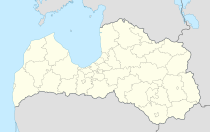Lielvārde
| Lielvārde ( German : Lennewarden) | ||
|---|---|---|
 |
|
|
| Basic data | ||
| State : |
|
|
| Landscape: | Livonia ( Latvian : Vidzeme ) | |
| Administrative district : | Lielvārdes novads | |
| Coordinates : | 56 ° 43 ' N , 24 ° 48' E | |
| Residents : | 6,498 (Jan 1, 2016) | |
| Area : | 10 km² | |
| Population density : | 650 inhabitants per km² | |
| Height : | 47 m | |
| City law: | since 1992 | |
| Website: | www.lielvarde.lv | |
| Post Code: | ||
| ISO code: | ||
Lielvārde (Eng .: Lennewarden ) is a city in Latvia .
Location and inhabitants
The town of Lielvārde is located in the Vidzeme region on the right bank of the Daugava River (Latvian: Daugava ), 52 km southeast of Riga . It has 6,328 inhabitants (as of February 2006)
history
On the banks of the Daugava, Livs and the Balts met and many prehistoric objects could be recovered here. The Chronicle of Heinrich von Livland ( Latin : Heinrici Cronicon Livoniae ) describes a fortress of the Baltic people on a mountain, which was conquered by Albert von Buxthoeven in 1201 and called "Lennewarden". In Latvian this place is called “Dievukalns” ( Mountain of the Gods ). The Archbishops of Riga built Lennewarden Castle on this site in 1229 . The ruins visible today date from the 14th century and are located opposite the original complex. A parish school was established during the period when Livonia was part of Sweden . 70% of the population fell victim to the great plague epidemic of 1710. The construction of the Riga- Dünaburg railway line in 1861 led to an expansion of the city around the Rembate station. The city was completely destroyed during World War I , but rebuilt soon after Latvian independence.
The history of the city after the occupation by the Soviet Union in 1940 is closely linked to the person of Edgars Kauliņš (1903–1979), the local party secretary of the CPSU . He succeeded in preventing local farmers from being deported as kulaks . In 1948 Kauliņš was the founding chairman of the kolkhoz "Lāčplēsis" ( Bear Killer ), which became known throughout Latvia for the beer it brewed. The beer is still brewed in Lielvārde by the AS Lāčplēša alus brewery, which has been part of the Scandinavian Royal Unibrew since 2005 . The air base, built by the Soviet military in 1970, was the largest in the Baltic States and was taken over by the Latvian Air Force in 1994.
Specialty
The area around Lielvārde is famous for having inspired the prominent Latvian poets Auseklis and Andrejs Pumpurs , author of the epic “Lāčplēsis” ( Bear Killer , 1888). Also Lielvārdes josta , a traditional woven belt with 22 ancient symbols, is well known in Latvia. Sections of the belt pattern are depicted on the Latvian banknotes , the symbols have inspired many Latvian artists, they are revered by the Dievturi religious community and many folklore enthusiasts.
literature
- Arveds Švābe, ed .: Latvju enciklopēdija . Stockholm: Trīs Zvaigznes, 1952–1953.
- Guntis Zemītis, Ornaments un simbols Latvijas aizvēsturē . Rīga: Latvijas vēstures institūta apgāds, 2004. ISBN 9984-601-20-X .
- James A. Brundage, The Chronicle of Henry of Livonia . Madison: University of Wisconsin Press, 1961.
- Astrīda Iltnere (ed.): Latvijas Pagasti, Enciklopēdija. Preses Nams, Riga 2002, ISBN 9984-00-436-8 .
Web links
- Lielvārdes Josta ("the belt from Lielvārde"), documentary film from 1980 about traditional Latvian weaving art, especially from Lielvārde (Latvian)

